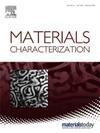使用新型 ZrCu 合金钎焊的 Zr-3/CoCrFeMnNi 高熵合金接头的显微结构和机械性能
IF 4.8
2区 材料科学
Q1 MATERIALS SCIENCE, CHARACTERIZATION & TESTING
引用次数: 0
摘要
本文采用真空熔炼法设计了 Zr53Cu47 (wt%) 合金,用于连接锆 (Zr) 合金和等原子 CoCrFeMnNi 高熵合金 (HEA)。具体研究了湿润、微观结构、反应层生长动力学、剪切强度以及接头随温度变化的断裂行为。确定了从 HEA 到 Zr-3 的界面反应为 CrMn 层/Zr(Cr,Mn)2 层 + 团状 β-Zr/ 团状 Zr2(Cu,Ni,Co,Fe)+Zrss+团状 Zr(Cr,Mn)2。其中,具有立体塑性的β-Zr析出物与基体相Zr(Cr,Mn)2具有半相干性,β-Zr析出物随温度升高而发展,促进了Zr(Cr,Mn)2塑性的改善和接头性能的增长。铬锰的活化能(Q)为 127.0 kJ/mol,明显低于 Zr(Cr,Mn)2 的活化能(159.7 kJ/mol),因此在钎焊过程中,铬锰的生成是 Zr(Cr,Mn)2 的基础。此外,CrMn 和 Zr(Cr,Mn)2 的晶粒取向是随机分散的。在 970 °C/10 分钟的钎焊温度下,Zr-3/Zr53Cu47/HEA 的强度达到 136.8 兆帕的峰值。裂纹最好从晶格失配度较高的 Zr(Cr,Mn)2/CrMn(I 区)的非相干界面(26.0%)开始,并向 II 区的块状 Zr2(Cu,Ni,Co,Fe)扩展。本文章由计算机程序翻译,如有差异,请以英文原文为准。
Microstructure and mechanical property of Zr-3/CoCrFeMnNi high-entropy alloys joints brazed using a novel ZrCu alloys
In this paper, the Zr53Cu47 (wt%) alloys were designed by vacuum melting for the joining Zirconium (Zr) alloys to equiatomic CoCrFeMnNi high entropy alloys (HEA). The wetting, microstructure, growth kinetics of reaction layer, shear strength and rupture behavior of joints evolved with temperature were specifically deliberated. The interfacial reactions were determined to be CrMn layer/Zr(Cr,Mn)2 layer + corpuscular β-Zr/tuberous Zr2(Cu,Ni,Co,Fe) + Zrss + tuberous Zr(Cr,Mn)2 from HEA to Zr-3. Herein, the β-Zr precipitates with the sterling plasticity had the semi-coherent relationship with the matrix phase Zr(Cr,Mn)2, and β-Zr precipitates developed with the elevated temperature, contributing to the plasticity improvement of Zr(Cr,Mn)2 and the growth of joints properties. The activation energy (Q) of CrMn was 127.0 kJ/mol, significantly less than that that of Zr(Cr,Mn)2 (159.7 kJ/mol), thereby the generation of CrMn was underlying to Zr(Cr,Mn)2 during brazing. Moreover, grains orientations in CrMn and Zr(Cr,Mn)2 were stochastically dispersed. The strength of Zr-3/Zr53Cu47/HEA achieved peak of 136.8 MPa when brazed at 970 °C/10 min. Cracks were preferably started at the non-coherent interface of Zr(Cr,Mn)2/CrMn with the higher lattice mismatch degree of 26.0 % in I area, and propagated toward tuberous Zr2(Cu,Ni,Co,Fe) in II area.
求助全文
通过发布文献求助,成功后即可免费获取论文全文。
去求助
来源期刊

Materials Characterization
工程技术-材料科学:表征与测试
CiteScore
7.60
自引率
8.50%
发文量
746
审稿时长
36 days
期刊介绍:
Materials Characterization features original articles and state-of-the-art reviews on theoretical and practical aspects of the structure and behaviour of materials.
The Journal focuses on all characterization techniques, including all forms of microscopy (light, electron, acoustic, etc.,) and analysis (especially microanalysis and surface analytical techniques). Developments in both this wide range of techniques and their application to the quantification of the microstructure of materials are essential facets of the Journal.
The Journal provides the Materials Scientist/Engineer with up-to-date information on many types of materials with an underlying theme of explaining the behavior of materials using novel approaches. Materials covered by the journal include:
Metals & Alloys
Ceramics
Nanomaterials
Biomedical materials
Optical materials
Composites
Natural Materials.
 求助内容:
求助内容: 应助结果提醒方式:
应助结果提醒方式:


